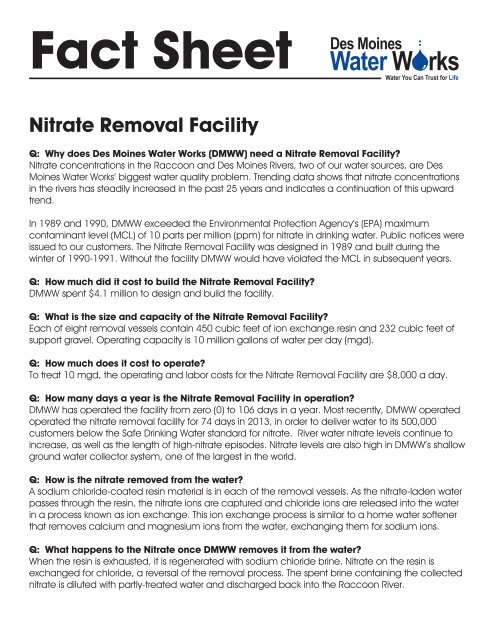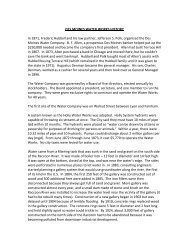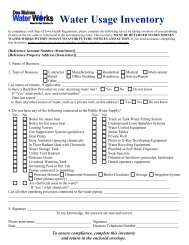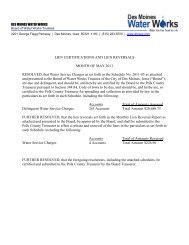Fact Sheet Nitrate Removal Facility - Des Moines Water Works
Fact Sheet Nitrate Removal Facility - Des Moines Water Works
Fact Sheet Nitrate Removal Facility - Des Moines Water Works
Create successful ePaper yourself
Turn your PDF publications into a flip-book with our unique Google optimized e-Paper software.
<strong>Fact</strong> <strong>Sheet</strong><strong>Des</strong> <strong>Moines</strong><strong>Water</strong> W rks<strong>Water</strong> You Can Trust for Life<strong>Nitrate</strong> <strong>Removal</strong> <strong>Facility</strong>Q: Why does <strong>Des</strong> <strong>Moines</strong> <strong>Water</strong> <strong>Works</strong> (DMWW) need a <strong>Nitrate</strong> <strong>Removal</strong> <strong>Facility</strong>?<strong>Nitrate</strong> concentrations in the Raccoon and <strong>Des</strong> <strong>Moines</strong> Rivers, two of our water sources, are <strong>Des</strong><strong>Moines</strong> <strong>Water</strong> <strong>Works</strong>’ biggest water quality problem. Trending data shows that nitrate concentrationsin the rivers has steadily increased in the past 25 years and indicates a continuation of this upwardtrend.In 1989 and 1990, DMWW exceeded the Environmental Protection Agency’s (EPA) maximumcontaminant level (MCL) of 10 parts per million (ppm) for nitrate in drinking water. Public notices wereissued to our customers. The <strong>Nitrate</strong> <strong>Removal</strong> <strong>Facility</strong> was designed in 1989 and built during thewinter of 1990-1991. Without the facility DMWW would have violated the MCL in subsequent years.Q: How much did it cost to build the <strong>Nitrate</strong> <strong>Removal</strong> <strong>Facility</strong>?DMWW spent $4.1 million to design and build the facility.Q: What is the size and capacity of the <strong>Nitrate</strong> <strong>Removal</strong> <strong>Facility</strong>?Each of eight removal vessels contain 450 cubic feet of ion exchange resin and 232 cubic feet ofsupport gravel. Operating capacity is 10 million gallons of water per day (mgd).Q: How much does it cost to operate?To treat 10 mgd, the operating and labor costs for the <strong>Nitrate</strong> <strong>Removal</strong> <strong>Facility</strong> are $8,000 a day.Q: How many days a year is the <strong>Nitrate</strong> <strong>Removal</strong> <strong>Facility</strong> in operation?DMWW has operated the facility from zero (0) to 106 days in a year. Most recently, DMWW operatedoperated the nitrate removal facility for 74 days in 2013, in order to deliver water to its 500,000customers below the Safe Drinking <strong>Water</strong> standard for nitrate. River water nitrate levels continue toincrease, as well as the length of high-nitrate episodes. <strong>Nitrate</strong> levels are also high in DMWW’s shallowground water collector system, one of the largest in the world.Q: How is the nitrate removed from the water?A sodium chloride-coated resin material is in each of the removal vessels. As the nitrate-laden waterpasses through the resin, the nitrate ions are captured and chloride ions are released into the waterin a process known as ion exchange. This ion exchange process is similar to a home water softenerthat removes calcium and magnesium ions from the water, exchanging them for sodium ions.Q: What happens to the <strong>Nitrate</strong> once DMWW removes it from the water?When the resin is exhausted, it is regenerated with sodium chloride brine. <strong>Nitrate</strong> on the resin isexchanged for chloride, a reversal of the removal process. The spent brine containing the collectednitrate is diluted with partly-treated water and discharged back into the Raccoon River.
Q: Does this create a bigger problem for the cities and water utilities downstream?No. Returning nitrate to the river does not impact the river’s total nitrate load. River nitrateconcentrations are so high that cities downstream would have a nitrate problem even if DMWW didnot discharge back into the river. For example, the daily nitrate load in the Raccoon River canapproach 700 tons; of this amount, less than 0.10% would pass through the nitrate removal facilityand be returned to the river. Other practical disposal methods are not available at this time.It’s also important to remember that DMWW actually decreases the nitrate load in the Raccoon Riverthrough the diversion of river water into the <strong>Water</strong> <strong>Works</strong> Park ponds and Crystal Lake (former gravalpit) near the Maffitt Treatment Plant. In the ponds and Crystal Lake, nitrate is consumed andconverted to nitrogen gas by the life processes of microorganisms before the water is dischargedback into the river or treated for customer use. DMWW removes about 75,000 pounds of nitrate fromthe river each year in this manner.Q: Does DMWW need special permission to discharge the nitrate back into the river?Yes, DMWW has two National Pollutant Discharge Elimination System (NPDES) permits allowingdischarge of the nitrate. Prior to issuing the permits, the Iowa Department of Natural Resources(IDNR), as authorized by the Federal Clean <strong>Water</strong> Act, requested public review and comment on thedischarge permits. The permits were also reviewed and approved by the Environmental ProtectionAgency (EPA).Q: How can we prevent nitrate from getting into our source water?The optimal solution is to prevent nitrate concentrations from entering our source water throughwatershed protection programs and good land management practices.Q: What are the health effects of nitrate?In infants under six months of age, nitrate may transform into nitrite in the infant’s body, reducing theability of blood to carry oxygen. This may cause “Blue Baby Syndrome,” a life threatening conditionrequiring immediate medical attention. Symptoms of “Blue Baby Syndrome” include the infantlooking blue and having shortness of breath.Blue Baby Syndrome is very seldom diagnosed today. But, on the horizon are other health concernsrelating to <strong>Nitrate</strong>s. Research supports a strong correlation between nitrates and certain types ofcancer in adults. There is also emerging data implicating nitrate as an endocrine disruptor, meaningnitrate may act as a hormone in the body.Q: Why are babies under six months of age at risk?(1) The intestinal pH is higher in infants, enhancing the bacterial conversion of nitrate to nitrite.(2) Infants require three times the fluid intake of adults, increasing the blood circulation and thenitrate absorption. (3) The infant’s immature kidneys reduce the excretion of the nitrate. (4) Thepresence of the enzyme responsible for preventing “Blue Baby Syndrome” is lower than in adults andchildren over six months of age.
Q: What is DMWW doing to help reduce or eleminate the nitrate problem?DMWW is committed to providing safe drinking water by building coalitions, implementing costeffective technology, and landscapes that will protect our water sources. A few of those projectsinclude:· DMWW is implementing environmentally-friendly methods to remove nitrate from source waterutilized for drinking water. Currently, these efforts are focused on a concept called off-riverstorage. River water is diverted into a reservoir where the tranquil water is conducive to the lifeprocessesof microorganisms that can remove nitrate from the water. No chemicals and verylittle energy is used to remove nitrate in this manner, and no waste is discharged back to the river.DMWW is committed to finding solutions to reduce nitrates in source waters used for drinkingwater. While the steps DMWW is taking to reduce nitrates in drinking water sources are worthy, theyare minimal in the overall battle to reduce Iowa’s nitrate concentrations impacting the MississippiRiver and ultimately the Gulf of Mexico.· DMWW is the only Iowa water utility to have a formal education program with a full-timeeducation coordinator. Classroom presentations are available for grade levels K-8. Tours ofDMWW facilities are available to adults and students. A newsletter “<strong>Water</strong> Wisdom” is sent toteachers quarterly. Educational emphasis include topics about our daily use of water, waterconservation, the water treatment process, and the importance of protecting our watersheds.· DMWW participates in the Urban Environmental Partnership, formed to provide an integratededucation program designed to educate the public on the importance of water qualityprotection through watershed protection in an urban area. Other members of the partnershipinclude, Metro Waste Authority, Wastewater Reclamation Authority and the City of <strong>Des</strong> <strong>Moines</strong>-Storm <strong>Water</strong> Division.· DMWW coordinates an annual Volunteer Monitoring Project in the Raccoon River <strong>Water</strong>shed. Thisproject produces crucial water quality data used by researchers and policy makers state-wide.· DMWW maintains an website to provide real time water quality information to anyonewith access to the Internet.For more information, call <strong>Des</strong> <strong>Moines</strong> <strong>Water</strong> <strong>Works</strong> at (515) 283-8700 or visit www.dmww.com.Updated November 13, 2014









